
N.T.H. Ngoc et al / Vietnam Journal of Community Medicine, Vol. 66, Special Issue 4, 128-135
128 www.tapchiyhcd.vn
GUIDELINES FOR ANALYZING THE GENETIC POLYMORPHISM
OF PLASMODIUM FALCIPARUM AND PLASMODIUM VIVAX
BASED ON WHOLE-GENOME SEQUENCING DATA
Nguyen Thi Hong Ngoc¹*, Nguyen Thi Huong Binh¹, Nguyen Quang Thieu¹
Nguyen Van Hong1, Nguyen Duc Giang1, Clark Taanea²
¹National Institute of Malariology, Parasitology and Entomology - 34 Trung Van, Nam Tu Liem district, Hanoi, Vietnam
²London School of Hygiene and Tropical Medicine - Keppel Street, London, WC1E 7HT, United Kingdom
Received: 28/02/2025
Reviced: 29/3/2025; Accepted: 11/4/2025
ABSTRACT
Objective: This study provides a guideline for analyzing the genetic polymorphism of Plasmodium
falciparum and Plasmodium vivax using whole-genome sequencing data.
Research methods: A standardized workflow for genomic data analysis was applied, including
variant calling (SNPs, InDels) from raw sequencing data, variant annotation and classification,
phylogenetic tree construction and population structure analysis, and association analysis between
genetic variants and antimalarial drug resistance.
Results: The total number of SNPs detected ranged from 50,000-80,000 in P. falciparum and 40,000-
60,000 in P. vivax, while InDels varied between 5,000 and 15,000. The pfcrt (72-76 CVIET) mutation
associated with Chloroquine resistance was highly prevalent, reaching 92.7% (51/55) in 2017-2018
and 91.1% (72/79) in 2019-2020 in Vietnam, whereas its prevalence in Africa was significantly lower
(< 5%) due to the transition to Artemisinin-based treatments. The k13 C580Y mutation, a key marker
of Artemisinin resistance, was most frequently observed along the Thailand - Cambodia border
(60%). In Vietnam, the mutation had a prevalence of 82% (41/50), indicating the regional spread of
resistant strains within Southeast Asia. Notably, the pfmdr1 copy number variation (> 1.5 copies),
associated with Mefloquine resistance, was detected in 23.6% (13/55) of cases in 2017-2018, but this
decreased to 1.3% (1/79) in 2019-2020 in Vietnam.
Conclusion: The application of whole-genome sequencing combined with advanced bioinformatics
approaches provides crucial insights into the genetic polymorphism of malaria parasites, supporting
drug resistance surveillance and informing more effective malaria control strategies.
Keywords: Plasmodium falciparum, Plasmodium vivax, genetic polymorphism, whole-genome
sequencing, drug resistance.
*Corresponding author
Email: ngocnime@gmail.com Phone: (+84) 983665694 Https://doi.org/10.52163/yhc.v66iCD4.2343
Vietnam Journal of Community Medicine, Vol. 66, Special Issue 4, 128-135

N.T.H. Ngoc et al / Vietnam Journal of Community Medicine, Vol. 66, Special Issue 4, 128-135
129
HƯỚNG DẪN PHÂN TÍCH TÍNH ĐA HÌNH DI TRUYỀN CỦA
PLASMODIUM FALCIPARUM VÀ PLASMODIUM VIVAX
DỰA TRÊN SỐ LIỆU GIẢI TRÌNH TỰ TOÀN BỘ HỆ GEN
Nguyễn Thị Hồng Ngọc1*, Nguyễn Thị Hương Bình1, Nguyễn Quang Thiều1
Nguyễn Vân Hồng1, Nguyễn Đức Giang1, Clark Taanea2
1Viện Sốt rét, Ký sinh trùng và Côn trùng Trung ương - 34 Trung Văn, quận Nam Từ Liêm, Hà Nội, Việt Nam
2Đại học Vệ sinh và Y học nhiệt đới Luân Đôn - Keppel Street, London, WC1E 7HT, Vương quốc Anh
Ngày nhận bài: 28/02/2025
Ngày chỉnh sửa: 29/3/2025; Ngày duyệt đăng: 11/4/2025
TÓM TẮT
Mục tiêu: Nghiên cứu này hướng dẫn quy trình phân tích tính đa hình di truyền của Plasmodium
falciparum và Plasmodium vivax bằng cách sử dụng dữ liệu giải trình tự toàn bộ hệ gen.
Phương pháp nghiên cứu: Sử dụng quy trình chuẩn hóa phân tích dữ liệu hệ gen bao gồm: gọi biến
thể di truyền (SNPs, InDels) từ dữ liệu thô. Chú thích và phân loại biến thể. Xây dựng cây phát sinh
loài và đánh giá quần thể. Phân tích mối tương quan giữa biến thể di truyền và tính kháng thuốc.
Kết quả nghiên cứu: Tổng số SNPs phát hiện dao động từ 50.000-80.000 trong P. falciparum và
40.000-60.000 trong P. vivax, trong khi số lượng InDels dao động từ 5.000-15.000. Đột biến pfcrt
(72-76 CVIET) liên quan đến kháng Chloroquine có tần suất cao, đạt 92,7% (51/55) trong giai đoạn
2017-2018 và 91,1% (72/79) trong giai đoạn 2019-2020 tại Việt Nam, trong khi tỉ lệ này tại châu Phi
thấp hơn (< 5%) do chuyển đổi sang phác đồ điều trị dựa trên Artemisinin. Đột biến k13 C580Y, dấu
hiệu quan trọng của kháng Artemisinin, xuất hiện nhiều nhất tại biên giới Thái Lan - Campuchia
(60%), trong khi tại Việt Nam, nghiên cứu ghi nhận tần suất 82% (41/50), phản ánh xu hướng lan
rộng của các dòng kháng thuốc trong khu vực Đông Nam Á. Đáng chú ý, đột biến pfmdr1 (> 1,5
copy), liên quan đến kháng Mefloquine, được ghi nhận với tần suất 23,6% (13/55) trong giai đoạn
2017-2018, nhưng giảm xuống 1,3% (1/79) trong giai đoạn 2019-2020 tại Việt Nam.
Kết luận: Việc áp dụng giải trình tự toàn bộ hệ gen kết hợp với các phương pháp tin sinh học tiên
tiến có thể cung cấp thông tin quan trọng về tính đa hình di truyền của ký sinh trùng sốt rét, hỗ trợ
việc giám sát kháng thuốc và phát triển chiến lược kiểm soát sốt rét hiệu quả hơn.
Từ khoá: Plasmodium falciparum, Plasmodium vivax, đa hình di truyền, giải trình tự toàn bộ hệ gen,
kháng thuốc.
1. ĐẶT VẤN ĐỀ
Sốt rét là một trong những bệnh truyền nhiễm nguy
hiểm nhất trên thế giới, với khoảng 247 triệu ca mắc và
619.000 ca tử vong được ghi nhận năm 2021, chủ yếu
tại khu vực cận Sahara châu Phi và Đông Nam Á [1].
Trong số 5 loài Plasmodium có khả năng gây bệnh trên
người, P. falciparum là tác nhân chính gây sốt rét ác
tính và tử vong, trong khi P. vivax chiếm ưu thế tại các
khu vực nhiệt đới và có khả năng tạo ra giai đoạn ngủ
(hypnozoite), gây tái phát bệnh [2]. Việc sử dụng thuốc
chống sốt rét đã giúp giảm đáng kể tỉ lệ mắc bệnh và tử
vong trong những thập kỷ qua, nhưng sự phát triển của
các dòng ký sinh trùng kháng thuốc đang đe dọa đến
hiệu quả của các phác đồ điều trị hiện nay [3].
Tình trạng kháng thuốc của P. falciparum và P. vivax
đã được ghi nhận trên toàn cầu, đặc biệt là ở Đông Nam
Á. Các nghiên cứu đã chỉ ra đột biến pfcrt K76T liên
quan đến kháng Chloroquine đạt tỉ lệ > 80% tại nhiều
khu vực ở Đông Nam Á và Nam Mỹ, trong khi tại châu
Phi, tỉ lệ này giảm xuống dưới 5% do việc thay thế
Chloroquine bằng liệu pháp phối hợp Artemisinin
(ACTs) [4]. Đột biến k13 C580Y, một dấu ấn sinh học
quan trọng của kháng Artemisinin, lần đầu tiên được
phát hiện tại Campuchia và hiện nay đã lan rộng sang
nhiều quốc gia khác trong khu vực [5]. Đặc biệt, tại Việt
Nam, tỉ lệ đột biến k13 C580Y được ghi nhận lên đến
82% ở các tỉnh miền Trung - Tây Nguyên, phản ánh áp
lực chọn lọc mạnh mẽ từ việc sử dụng ACTs [6]. Ngoài
*Tác giả liên hệ
Email: ngocnime@gmail.com Điện thoại: (+84) 983665694 Https://doi.org/10.52163/yhc.v66iCD4.2343

N.T.H. Ngoc et al / Vietnam Journal of Community Medicine, Vol. 66, Special Issue 4, 128-135
130 www.tapchiyhcd.vn
ra, sự gia tăng bản sao pfmdr1 (> 1,5 copies) cũng đã
được xác định có liên quan đến kháng Mefloquine, với
tần suất cao vào năm 2017-2018 (23,6%) nhưng giảm
xuống còn 1,3% vào năm 2019-2020 tại Việt Nam [6].
Để đối phó với tình trạng kháng thuốc ngày càng gia
tăng, Tổ chức Y tế Thế giới đã khuyến nghị tăng cường
các phương pháp giám sát di truyền nhằm theo dõi sự
tiến hóa và lan rộng của các dòng ký sinh trùng kháng
thuốc [1]. Trong bối cảnh này, giải trình tự toàn bộ hệ
gen (WGS) đang nổi lên như một công cụ mạnh mẽ để
phân tích tính đa hình di truyền của Plasmodium, cung
cấp dữ liệu có độ phân giải cao về đột biến điểm
(SNPs), chèn/xóa (InDels) và các biến thể cấu trúc [7].
Không giống như các phương pháp phân tích gen đơn
lẻ truyền thống, WGS cho phép đánh giá toàn diện hệ
gen ký sinh trùng, giúp xác định các biến thể mới liên
quan đến kháng thuốc, phân tích cấu trúc quần thể và
theo dõi sự lan truyền của các dòng kháng thuốc theo
thời gian [8].
Tại Việt Nam, việc ứng dụng WGS trong nghiên cứu
sốt rét vẫn còn hạn chế, chủ yếu do yêu cầu cao về chi
phí và hạ tầng tin sinh học. Từ năm 2020-2024, với sự
hỗ trợ từ các dự án hợp tác quốc tế, đặc biệt là nhiệm
vụ Nghị định thư hợp tác với Vương quốc Anh mã số
NĐT.84.GB/20 với tên “Nghiên cứu tính đa hình di
truyền và kháng thuốc của Plasmodium falciparum và
Plasmodium vivax bằng kỹ thuật giải trình tự toàn bộ
hệ gen” hướng tới sử dụng WGS như một chiến lược
quan trọng trong công tác giám sát ký sinh trùng sốt rét
và kháng thuốc [6]. Do đó, nghiên cứu này được thực
hiện nhằm hướng dẫn quy trình phân tích tính đa hình
di truyền của P. falciparum và P. vivax bằng cách sử
dụng dữ liệu WGS. Mục tiêu của nghiên cứu bao gồm:
(1) Xác định các biến thể di truyền (SNPs, InDels) có
liên quan đến kháng thuốc; (2) Xây dựng cây phát sinh
loài để làm rõ mối quan hệ tiến hóa giữa các dòng ký
sinh trùng; và (3) Phân tích cấu trúc quần thể để đánh
giá sự phân hóa di truyền của Plasmodium tại Việt Nam
và trên thế giới. Những kết quả này không chỉ góp phần
nâng cao hiểu biết về cơ chế kháng thuốc mà còn hỗ trợ
xây dựng chiến lược kiểm soát sốt rét hiệu quả hơn
trong tương lai.
2. ĐỐI TƯỢNG, PHƯƠNG PHÁP NGHIÊN CỨU
2.1. Thiết kế nghiên cứu
Phân tích dữ liệu WGS của P. falciparum và P. vivax
nhằm xác định tính đa hình di truyền và mối liên quan
với tính kháng thuốc.
2.2. Thời gian và địa điểm nghiên cứu
- Thời gian: từ tháng 5/2023 đến tháng 3/2024.
- Địa điểm: Viện Sốt rét, Ký sinh trùng và Côn trùng
Trung ương và Đại học Vệ sinh và Y học Nhiệt đới
Luân Đôn.
2.3. Đối tượng nghiên cứu
Mẫu lâm sàng có chứa P. falciparum và P. vivax được
giải trình tự theo SOP NIMPE.HD03.PP.NĐT.GB-20.
2.4. Cỡ mẫu và phương pháp chọn mẫu
- 250 mẫu giải trình tự tại Viện Sốt rét, Ký sinh trùng
và Côn trùng Trung ương.
- 750 mẫu giải trình tự tại Đại học Vệ sinh và Y học
Nhiệt đới Luân Đôn.
- 100 mẫu tham khảo từ ngân hàng gen.
2.5. Các kỹ thuật sử dụng
- Lập bản đồ hệ gen: sử dụng Burrows-Wheeler Aligner
(BWA).
- Gọi biến thể: sử dụng GATK, SAMtools.
- Chú thích biến thể: sử dụng SnpEff, VEP.
- Xây dựng cây phát sinh loài: sử dụng RaxML.
2.5. Phân tích số liệu
- Xác định các biến thể SNPs, InDels.
- Đánh giá tần suất đột biến kháng thuốc.
- Xây dựng mô hình phân bố di truyền theo khu vực địa
lý.
2.6. Đạo đức nghiên cứu
Nghiên cứu là một phần của đề tài Nghị định thư giữa
Đại học Vệ sinh và Y học nhiệt đới Luân Đôn, Vương
quốc Anh với Viện Sốt rét, Ký sinh trùng và Côn trùng
Trung ương với tên “Nghiên cứu tính đa hình di truyền
và kháng thuốc của Plasmodium falciparum và
Plasmodium vivax bằng kỹ thuật giải trình tự toàn bộ
hệ gen” đã được thông qua Hội đồng Y đức của Viện
Sốt rét, Ký sinh trùng và Côn trùng Trung ương theo
Quyết định số 1096/QĐ-VSR ngày 20/8/2020.
3. KẾT QUẢ NGHIÊN CỨU
Việc phân tích tính đa hình di truyền của P. falciparum
và P. vivax đóng vai trò quan trọng trong nghiên cứu sự
tiến hóa của ký sinh trùng sốt rét, đặc biệt trong bối
cảnh gia tăng tình trạng kháng thuốc. Sự phát triển của
công nghệ WGS đã cung cấp một cách tiếp cận toàn
diện để xác định các biến thể di truyền, bao gồm SNPs,
InDels và các đột biến liên quan đến tính kháng thuốc.
Tuy nhiên, để đảm bảo tính chính xác và khả năng tái
lập của kết quả, cần có một quy trình phân tích chặt chẽ
từ bước tiền xử lý dữ liệu đến phân tích mối quan hệ
tiến hóa và cấu trúc quần thể. Quy trình này bao gồm
các bước chính:
- Tiền xử lý dữ liệu giải trình tự, bao gồm kiểm tra chất
lượng và căn chỉnh trình tự với bộ gen tham chiếu bằng
BWA-MEM.
- Gọi biến thể (variant calling) sử dụng GATK
HaplotypeCaller và bcftools để xác định SNPs và
InDels.

N.T.H. Ngoc et al / Vietnam Journal of Community Medicine, Vol. 66, Special Issue 4, 128-135
131
- Lọc và chú thích biến thể, giúp xác định các đột biến
quan trọng liên quan đến kháng thuốc bằng SnpEff.
- Phân tích liên kết toàn hệ gen (GWAS) để xác định
mối liên hệ giữa các đột biến và tính kháng thuốc.
- Xây dựng cây phát sinh loài sử dụng RAxML nhằm
đánh giá quan hệ tiến hóa giữa các chủng ký sinh trùng.
- Phân tích cấu trúc quần thể bằng ADMIXTURE để
xác định sự phân hóa di truyền giữa các quần thể khác
nhau.
Hướng dẫn dưới đây sẽ trình bày chi tiết từng bước
trong quy trình này, cung cấp một cách tiếp cận có hệ
thống nhằm khai thác tối đa dữ liệu WGS, hỗ trợ giám
sát kháng thuốc và đề xuất các chiến lược kiểm soát sốt
rét hiệu quả hơn.
3.1. Gọi biến thể và phân loại SNPs/InDels
3.1.1. Quy trình phân tích
Phân tích tính đa hình di truyền của P. falciparum và
P. vivax bắt đầu từ việc gọi biến thể từ dữ liệu WGS.
Quá trình này bao gồm 3 giai đoạn chính: tiền xử lý dữ
liệu, gọi biến thể (variant calling) và chú thích biến thể
(variant annotation).
Dữ liệu giải trình tự (định dạng FASTQ) được căn
chỉnh với bộ gen tham chiếu của P. falciparum (Pf3D7)
và P. vivax (Pvp01) bằng phần mềm Burrows-
Wheeler Aligner (BWA-MEM). Lệnh thực hiện căn
chỉnh: bwa mem -t 8 -R
“@RG\tID:sample\tSM:sample\tPL:ILLUMINA”
ref_genome.fasta sample_R1.fastq sample_R2.fastq |
samtools view -bS- | samtools sort -o
sample_sorted.bam.
Trong đó: -t 8 là chỉ định số luồng xử lý; R là gán thông
tin nhóm đọc; samtools view -bS- là chuyển đổi đầu ra
sang định dạng BAM; samtools sort -o giúp sắp xếp dữ
liệu theo thứ tự gen.
Sau khi căn chỉnh, file BAM được lọc bỏ các trình tự
không đạt chất lượng với SAMtools bằng lệnh:
samtools view -q 30 -b sample_sorted.bam >
sample_filtered.bam.
Gọi biến thể (variant calling) được thực hiện bằng
GATK HaplotypeCaller, công cụ để xác định SNPs
(Single Nucleotide Polymorphisms - đa hình nucleotide
đơn), và InDels (Insertions and Deletions - đột biến
chèn/xóa hoặc chèn/xóa nucleotide). Lệnh gọi biến thể
như sau: gatk HaplotypeCaller -R ref_genome.fasta -I
sample_filtered.bam -O sample_raw.vcf -ERC GVCF.
Sau khi thực hiện các lệnh trên, thu được file VCF chứa
danh sách các biến thể có định dạng như sau:
##fileformat=VCFv4.2
##source=GATK HaplotypeCaller
##reference=Pf3D7_v3.fasta
##contig=<ID=Pf3D7_01,length=640851>
##contig=<ID=PvP01_01,length=342324>
##INFO=<ID=DP,Number=1,Type=Integer,Description="Total read depth">
##INFO=<ID=AF,Number=A,Type=Float,Description="Allele Frequency">
##FORMAT=<ID=GT,Number=1,Type=String,Description="Genotype">
##FORMAT=<ID=AD,Number=R,Type=Integer,Description="Allelic depths">
##FORMAT=<ID=DP,Number=1,Type=Integer,Description="Read depth">
##FORMAT=<ID=GQ,Number=1,Type=Integer,Description="Genotype Quality">
#
CHROM
POS
ID
REF
ALT
QUAL
FILTER
INFO
FORMAT
Sample1
Sample2
Pf3D7
01
10523
.
A
G
99.0
PASS
DP=120;AF=0.45
GT:AD:DP:GQ
0/1:50,70:120:99
1/1:0,120:120:99
Pf3D7
01
10523
rs12345
C
T
75.0
PASS
DP=80;AF=0.60
GT:AD:DP:GQ
0/1:30,50:80:75
0/0:80,0:80:90
PvP01
01
10523
.
G
A,T
88.0
PASS
DP=200;AF=0.30,0.20
GT:AD:DP:GQ
1/2:60,80,60:200:
0/1:120,80:200:85
Pf3D7
01
349872
.
AT
A
60.0
PASS
DP=90;AF=0.35
GT:AD:DP:GQ
0/1:55,35:90:80
1/1:0,90:90:99
PvP01
01
76234
.
C
CTG
95.0
PASS
DP=150;AF=0.40
GT:AD:DP:GQ
0/1:90,60:150:95
0/0:150,0:150:99
Trong đó:
CHROM
Sắc thể chứa biến thể (Pf3D7_01 là của P. falciparum, PvP01_01 là của P. vivax).
POS
Vị trí nucleotide trên sắc thể.
ID
ID của biến thể (nếu có, nếu không có thì thể hiện là dấu “.”).
REF
Base nucleotide trong bộ gen tham chiếu.
ALT
Base nucleotide thay thế (SNPs hoặc InDels).
QUAL
Điểm chất lượng biến thể (giá trị càng cao, độ tin cậy càng lớn).
FILTER
Trạng thái lọc biến thể (PASS nếu đạt yêu cầu).
INFO
Các thông tin bổ sung như DP (Read Depth - độ sâu đọc), AF (Allele Frequency - tần suất alen).

N.T.H. Ngoc et al / Vietnam Journal of Community Medicine, Vol. 66, Special Issue 4, 128-135
132 www.tapchiyhcd.vn
Để tăng độ tin cậy, tiếp tục sử dụng lệnh GATK
VariantFiltration với các tiêu chí lọc:
gatk VariantFiltration -R refgenome.fasta -V
sample_raw.vcf -O sample_filtered.vcf
--filter-expression "QD < 2.0 || FS > 60.0 || MQ <
40.0" --filter-name "LowQuality"
Sau khi lọc biến thể, tiến hành chú thích biến thể bằng
SnpEff, để dự đoán ảnh hưởng của các đột biến đến
quá trình mã hóa protein: snpEff ann -v Pf3D7
sample_filtered.vcf > sample_annotated.vcf.
Với lệnh này sẽ tạo ra file có các có chú thích các điểm
đột biến có thể ảnh hưởng đến việc mã hóa các axit
amin trong protein dưới dạng chuỗi như sau:
#CHROM POS ID REF ALT QUAL FILTER
Pf3D7_ 01 10523 . A G 99.0 PASS
INFO
DP=120;AF=0.45;ANN=G|MODERATE|pfcrt|PF3D7
_0709000|transcript|PF3D7_0709000.1|protein_codin
g|1/1|c.76A>G|p.Lys76Thr|230/1200|76/400|25/133||
Trong đó:
- G: Base thay thế, trong trường hợp này là đột biến từ
A → G.
- MODERATE: Mức độ ảnh hưởng của biến thể. Có 3
mức độ chính: LOW (ảnh hưởng thấp), MODERATE
(ảnh hưởng trung bình), và HIGH (ảnh hưởng cao).
Đột biến này được đánh giá có ảnh hưởng trung bình
đến protein.
- pfcrt: Tên gen bị ảnh hưởng. Trong trường hợp này,
đột biến xảy ra trong gen pfcrt, một gen quan trọng liên
quan đến kháng Chloroquine.
- PF3D7_0709000: ID của gen bị ảnh hưởng trong bộ
gen tham chiếu P. falciparum 3D7.
- transcript: Loại vùng ảnh hưởng, cho biết đột biến
này nằm trên một đoạn mRNA transcript.
- PF3D7_0709000.1: ID của phiên mã gen bị ảnh
hưởng.
- protein_coding: Loại gen, trong trường hợp này là
mã hóa protein. Điều này có nghĩa là đột biến có thể
ảnh hưởng đến chức năng của protein.
- 1/1: Kiểu gen của mẫu. Giá trị 1/1 thể hiện rằng mẫu
bệnh phẩm này có đột biến đồng hợp tử, tức là cả hai
bản sao của gen này đều mang đột biến.
- c.76A>G: Đột biến theo mã trình tự cDNA. Đột biến
xảy ra tại nucleotide thứ 76, thay đổi từ A → G.
- p.Lys76Thr: Đột biến ở mức protein. Đây là một thay
đổi acid amin, trong đó Lysine (K) ở vị trí 76 đã bị thay
thế bằng Threonine (T).
- 76/400: Vị trí đột biến trên trình tự mã hóa (CDS -
Coding Sequence). Đột biến này nằm ở nucleotide 76
trên tổng số 400 nucleotide trong vùng mã hóa của
gen.
- 25/133: Vị trí đột biến trên protein. Đột biến này ảnh
hưởng đến acid amin thứ 25 trên tổng số 133 acid amin
của protein.
Sau quá trình phân tích tạo được file chú giải có dạng
“tên file”_annotated.vcf đóng vai trò quan trọng trong
nghiên cứu sốt rét, đặc biệt trong việc phân tích các biến
thể di truyền liên quan đến tính kháng thuốc của P.
falciparum và P.vivax. Tệp dữ liệu giúp xác định các
đột biến kháng thuốc, chẳng hạn như pfcrt K76T liên
quan đến kháng Chloroquine và k13 C580Y liên quan
đến kháng Artemisinin, từ đó hỗ trợ giám sát sự lan
truyền của các dòng ký sinh trùng kháng thuốc trong
quần thể. Bên cạnh đó, việc chú thích biến thể giúp dự
đoán tác động của từng đột biến đến protein, với mức
độ ảnh hưởng được phân loại thành thấp (LOW), trung
bình (MODERATE) hoặc cao (HIGH), qua đó đánh giá
mức độ nguy cơ của từng biến thể đối với chức năng
sinh học của ký sinh trùng. Tệp VCF được chú thích có
thể được sử dụng để lọc các biến thể có ý nghĩa sinh
học, giúp tập trung vào các đột biến có ảnh hưởng đáng
kể đến protein và có liên quan trực tiếp đến cơ chế
kháng thuốc.
3.1.2. Kết quả phân tích
Từ dữ liệu giải trình tự, số lượng lớn SNPs và InDels
đã được phát hiện. Trong P. falciparum, tổng số SNPs
dao động từ 50.000-80.000, trong khi số lượng InDels
dao động từ 5.000-15.000. Đối với P. vivax, số lượng
SNPs thấp hơn, khoảng 40.000-60.000, với số lượng
InDels từ 4.000-10.000.
Phân bố của SNPs/InDels cũng cho thấy sự khác biệt
quan trọng. Khoảng 60% SNPs nằm trong các vùng
không mã hóa, nhưng có khả năng ảnh hưởng đến điều
hòa gen. Các SNPs quan trọng được phát hiện trong các
gen liên quan đến kháng thuốc như pfcrt (K76T,
N75E), k13 (C580Y, R539T), và pfmdr1 (N86Y,
Y184F).
3.2. Phân tích mối tương quan với tính kháng thuốc
Tình trạng kháng thuốc của P. falciparum và P. vivax
đã trở thành mối đe dọa nghiêm trọng đối với các chiến
lược kiểm soát và điều trị sốt rét. Việc xác định mối
liên hệ giữa các biến thể di truyền và khả năng kháng
thuốc giúp làm rõ cơ chế kháng thuốc và hỗ trợ phát
triển các phác đồ điều trị hiệu quả hơn. Phân tích này
dựa trên dữ liệu biến thể từ file VCF đã được chú thích,
kết hợp với dữ liệu lâm sàng và thông tin về hiệu quả
điều trị thuốc. Các bước thực hiện bao gồm:
- Xác định các đột biến đã biết liên quan đến kháng
thuốc, chẳng hạn như pfcrt K76T (kháng Chloroquine)
và k13 C580Y (kháng Artemisinin).

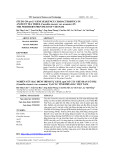


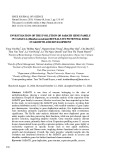
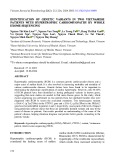

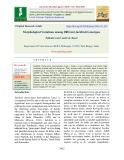

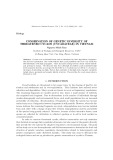
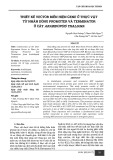



![Bài tập Đa dạng thế giới sống [kèm đáp án/ hướng dẫn giải]](https://cdn.tailieu.vn/images/document/thumbnail/2025/20251123/thaohoang9203@gmail.com/135x160/5861763951302.jpg)











